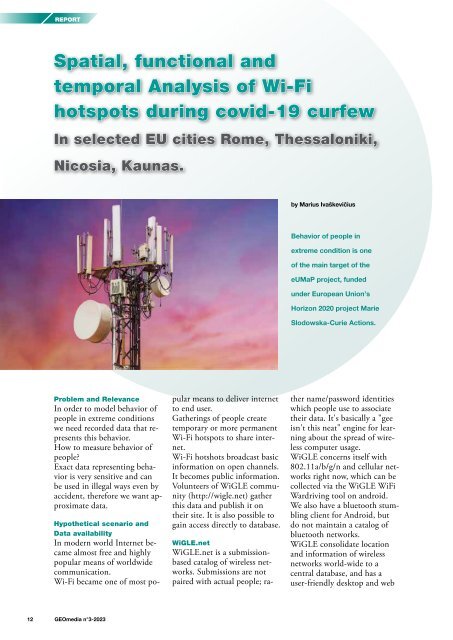GEOmedia_3_2023
EUMAP During the recent pandemic period, the world's attention has shifted towards the healthcare sector, with world leaders striving to avoid the collapse of their national healthcare systems; the economy has entered an artificial coma, while utility systems, including energy, water, telecommunications and waste management systems, have been asked to act immediately in response to these unprecedented conditions, placing extreme pressure on public utility systems.
EUMAP
During the recent pandemic period, the world's attention has shifted towards the healthcare sector, with world leaders striving to avoid the collapse of their national healthcare systems; the economy has entered an artificial coma, while utility systems, including energy, water, telecommunications and waste management systems, have been asked to act immediately in response to these unprecedented conditions, placing extreme pressure on public utility systems.
You also want an ePaper? Increase the reach of your titles
YUMPU automatically turns print PDFs into web optimized ePapers that Google loves.
REPORT<br />
Spatial, functional and<br />
temporal Analysis of Wi-Fi<br />
hotspots during covid-19 curfew<br />
In selected EU cities Rome, Thessaloniki,<br />
Nicosia, Kaunas.<br />
by Marius Ivaškevičius<br />
Behavior of people in<br />
extreme condition is one<br />
of the main target of the<br />
eUMaP project, funded<br />
under European Union’s<br />
Horizon 2020 project Marie<br />
Slodowska-Curie Actions.<br />
Problem and Relevance<br />
In order to model behavior of<br />
people in extreme conditions<br />
we need recorded data that represents<br />
this behavior.<br />
How to measure behavior of<br />
people?<br />
Exact data representing behavior<br />
is very sensitive and can<br />
be used in illegal ways even by<br />
accident, therefore we want approximate<br />
data.<br />
Hypothetical scenario and<br />
Data availability<br />
In modern world Internet became<br />
almost free and highly<br />
popular means of worldwide<br />
communication.<br />
Wi-Fi became one of most popular<br />
means to deliver internet<br />
to end user.<br />
Gatherings of people create<br />
temporary or more permanent<br />
Wi-Fi hotspots to share internet.<br />
Wi-Fi hotshots broadcast basic<br />
information on open channels.<br />
It becomes public information.<br />
Volunteers of WiGLE community<br />
(http://wigle.net) gather<br />
this data and publish it on<br />
their site. It is also possible to<br />
gain access directly to database.<br />
WiGLE.net<br />
WiGLE.net is a submissionbased<br />
catalog of wireless networks.<br />
Submissions are not<br />
paired with actual people; rather<br />
name/password identities<br />
which people use to associate<br />
their data. It's basically a "gee<br />
isn't this neat" engine for learning<br />
about the spread of wireless<br />
computer usage.<br />
WiGLE concerns itself with<br />
802.11a/b/g/n and cellular networks<br />
right now, which can be<br />
collected via the WiGLE WiFi<br />
Wardriving tool on android.<br />
We also have a bluetooth stumbling<br />
client for Android, but<br />
do not maintain a catalog of<br />
bluetooth networks.<br />
WiGLE consolidate location<br />
and information of wireless<br />
networks world-wide to a<br />
central database, and has a<br />
user-friendly desktop and web<br />
12 <strong>GEOmedia</strong> n°3-<strong>2023</strong>

















